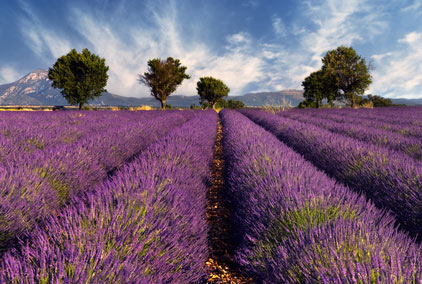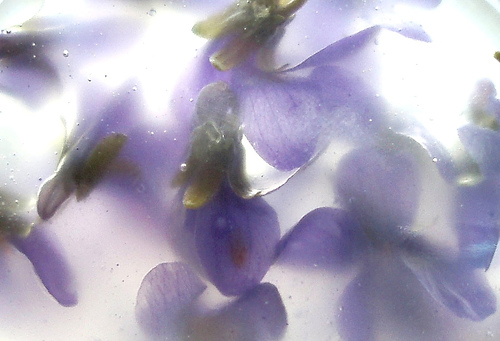In a lot of my soap making videos, I simply show myself adding a particular fragrance to the soap without explaining much about the different options there are to making your soap smell like it just came out of a designer spa but at a far cheaper price. In this article I hope to explain some of the basics to adding fragrance to your soap so that you can feel more confident to experiment with your own scents as you join the wonderful community of soapmakers.There are basically two chances you will have to add fragrance to your soap. The most common way is to add either a fragrance oil or a pure essential oil to your soap. The second way in which to add scent to your soap is to use various aromatic liquids like tea or coffee. There is a third way that is sometimes suggested by adding herbs or flowers to your soap but I have never had much luck with this method and if the cuttings are not heat safe, you will find most of the time they end up being burned by the saponification process.
Fragrance Oil vs Essential Oil
There is a long debate in the soap making community between those that use fragrance oils and those that use essential oils to scent their soap. The basic difference is that one is considered synthetic and the other is considered natural. In the United States fragrance oils are formulas or special combinations of chemicals or essential oils that produce a unique scent and can be protected by the FDA. On the other hand essential oils are tend to be a single ingredient that is extracted from a plant or other piece of verdure. Because the ingredients are known the essential oils tend to be considered more natural. The decision to use either material is really up to you but here are some of the facts you will need to know for soap making.
Fragrance Oils
Fragrance oils are by far cheaper to use and have a far wider variety of scents you can add to your soap. The drawback to using fragrance oils is that some of the oils can lead to a failed soap batch. Because the ingredients are often not disclosed, it is hard to tell the probability of failure of your soap when adding a new fragrance oil. That being said, I have used fragrance oils for some of my soaps and have never had a batch seize on me.
Essential Oils
Essential oils are considered more natural but the process by which they are extracted may be anything but natural. So if one of the reasons you are using essential oils is to be greener, be sure to know how the oil was extracted and be sure the plant that is providing the oil is being harvested in environmentally sustainable ways. Essential oils provide a stronger scent and often times last longer in finished soaps. If you plan on having your soap giving a room aroma for months and only on display, you’ll more than likely want to uses some combination of essential oils. Another benefit of essential oils is that they are a known ingredient and because of that the probability of a failed soap batch is known ahead of time. Unfortunately, because some plants don’t offer much in the way of oil getting your hands on some essential oils can cost an arm and a leg.Essential Oils that WorkHere is a list of essential oils that tend to withstand the saponification process quite well and come out smelling like what they did before they were turned into soap:
- Almond
- Cinnamon (be careful with this one)
- Citronella
- Cloves
- Eucalyptus
- French Lavender
- Jasmine
- Orange
- Patchoili
- Peppermint (this can irritate the skin)
- Rose
- Sage
- Vanilla
How much should I use?Probably the most important question to ask is the amount to use to get the scent you want after your soap has set. This is actually a personal question for you to answer. It will depend on how the soap is being used (or not used). If the soap is merely for decoration, then you can go ahead and load it up with fragrance. On the other hand if you actually want to use the soap, you need to be aware of how the fragrance/essential oil you used will react to your skin. Having a cinnamon scented soap for general shower use might not be a good idea but having it for a foot wash would be ideal. I tend to follow the general rule that for every 30 oz of soap oil I used 1.5 to 2 oz of fragrance. I’ve found this gives me enough scent to come through the soap making process while still being easy on my skin.The next most important question is that of timing. This is actually a simple answer. Unless otherwise specified in a recipe, the fragrance (and all other additives like color, herbs or old soap pieces) right before the soap has reached full trace. Once you add the additives only a few more mixes of the soap is needed. If you mix more, there is more of a chance the things you just added will seize your soap or cause it to streak.
Liquid Scenting
Another way which you can add scent to your soap is by using a special tea or coffee as the liquid base for your soap. When you are making the liquid, you will want to make sure you make it very strong. This liquid is not for drinking and would probably taste horrible because it is so strong but what you are after are the qualities of the tea/coffee/juice as well as the scent. I’ve found that sage tea makes a good scent as well as coffee. The only thing to be aware of is that theses liquids can change the pH of the water. This will effect how your lye processes the oil. More often than not the liquid will tend to become more acidic. This in turn will cause a stronger reaction when you add the lye to your water.As you make more and more soap batches, you will become more comfortable adding fragrance to your soap and coming up with fabulously creative ideas! Good Luck!
 The use of flowers as perfume dates back too far to be traced by man. At one time diseases were thought to be transmitted through bad odors, which led to the use of flowers and scents to purify the air. Religious ceremonies using herbs and resins have been used since Egyptian times. Over the centuries flowers have taken on a special meaning. In soap making, these fragrances are prized and often times hard to come by when looking for the perfect scent.
The use of flowers as perfume dates back too far to be traced by man. At one time diseases were thought to be transmitted through bad odors, which led to the use of flowers and scents to purify the air. Religious ceremonies using herbs and resins have been used since Egyptian times. Over the centuries flowers have taken on a special meaning. In soap making, these fragrances are prized and often times hard to come by when looking for the perfect scent. Seal the plates together with tape and put them aside for two days. After this time you should remove the wilted petals and repeat this process using fresh petals. After eight changes of flowers cut the lard and place it in several small sterile glass bottles, filling each half full. Top this off with pure ethyl alcohol or if cannot get ethyl alcohol that is pure, you can use rubbing alcohol as well. Close each of the bottles tightly and shake them thoroughly. Then place them in a dark area for about 12 weeks. You will need to shake each bottle daily if possible to blend the ingredients. When the 12 weeks are up, use a funnel with a piece of muslin placed over it to pour the perfume into a bottle. The muslin will strain out all the fat globules. Next you should add a very small amount of fixative oil as a preservative. If you prefer to measure the amount of fixative it should be approximately two drops per 1/4 cup of perfume. In this process the aroma of the petals you have chosen are absorbed by the lard and held by the alcohol. The best aromatic flowers to use are gardenias, roses, honey suckle, lavender and carnations. Any aromatic mixture must be composed carefully to achieve the perfect blend. It is best to choose one ingredient for the primary fragrance and then add small amounts of other scents to get the best results.
Seal the plates together with tape and put them aside for two days. After this time you should remove the wilted petals and repeat this process using fresh petals. After eight changes of flowers cut the lard and place it in several small sterile glass bottles, filling each half full. Top this off with pure ethyl alcohol or if cannot get ethyl alcohol that is pure, you can use rubbing alcohol as well. Close each of the bottles tightly and shake them thoroughly. Then place them in a dark area for about 12 weeks. You will need to shake each bottle daily if possible to blend the ingredients. When the 12 weeks are up, use a funnel with a piece of muslin placed over it to pour the perfume into a bottle. The muslin will strain out all the fat globules. Next you should add a very small amount of fixative oil as a preservative. If you prefer to measure the amount of fixative it should be approximately two drops per 1/4 cup of perfume. In this process the aroma of the petals you have chosen are absorbed by the lard and held by the alcohol. The best aromatic flowers to use are gardenias, roses, honey suckle, lavender and carnations. Any aromatic mixture must be composed carefully to achieve the perfect blend. It is best to choose one ingredient for the primary fragrance and then add small amounts of other scents to get the best results.